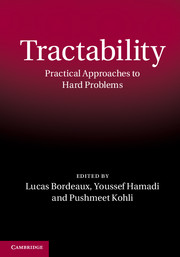1 - Treewidth and Hypertree Width
from Part 1 - Graphical Structure
Published online by Cambridge University Press: 05 February 2014
Summary
This chapter covers methods for identifying islands of tractability for NP-hard combinatorial problems by exploiting suitable properties of their graphical structure. Acyclic structures are considered, as well as nearly-acyclic ones identified by means of so-called structural decomposition methods. In particular, the chapter focuses on the tree decomposition method, which is the most powerful decomposition method for graphs, and on the hypertree decomposition method, which is its natural counterpart for hypergraphs. These problem-decomposition methods give rise to corresponding notions of width of an instance, namely, treewidth and hypertree width. It turns out that many NP-hard problems can be solved efficiently over classes of instances of bounded treewidth or hypertree width: deciding whether a solution exists, computing a solution, and even computing an optimal solution (if some cost function over solutions is specified) are all polynomial-time tasks. Example applications include problems from artificial intelligence, databases, game theory, and combinatorial auctions.
Many NP-hard problems in different areas such as AI [42], Database Systems [6, 81], Game theory [45, 31, 20], and Network Design [34], are known to be efficiently solvable when restricted to instances whose underlying structures can be modeled via acyclic graphs or acyclic hypergraphs. For such restricted classes of instances, solutions can usually be computed via dynamic programming. However, as a matter of fact, (graphical) structures arising from real applications are in most relevant cases not properly acyclic. Yet, they are often not very intricate and exhibit some rather limited degree of cyclicity, which suffices to retain most of the nice properties of acyclic instances.
Information
- Type
- Chapter
- Information
- TractabilityPractical Approaches to Hard Problems, pp. 3 - 38Publisher: Cambridge University PressPrint publication year: 2014
Accessibility standard: Unknown
Why this information is here
This section outlines the accessibility features of this content - including support for screen readers, full keyboard navigation and high-contrast display options. This may not be relevant for you.Accessibility Information
- 10
- Cited by
